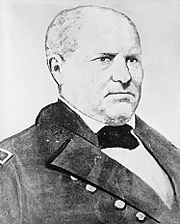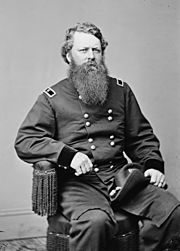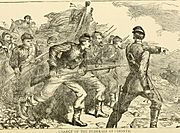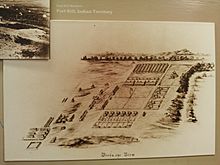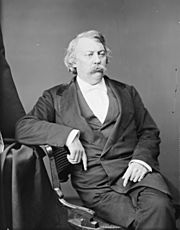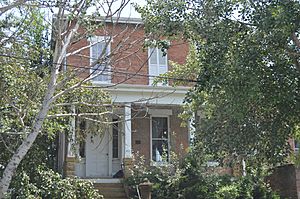William W. Belknap facts for kids
Quick facts for kids
William Belknap
|
|
|---|---|
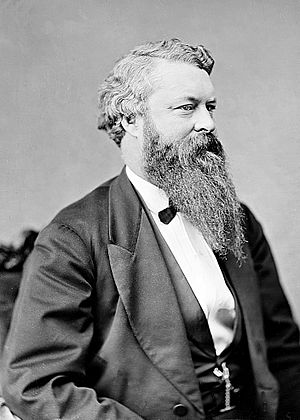 |
|
| 30th United States Secretary of War | |
| In office October 25, 1869 – March 2, 1876 |
|
| President | Ulysses S. Grant |
| Preceded by | William Tecumseh Sherman (acting) |
| Succeeded by | Alphonso Taft |
| Personal details | |
| Born |
William Worth Belknap
September 22, 1829 Newburgh, New York, U.S. |
| Died | October 12, 1890 (aged 61) Washington, D.C., U.S. |
| Political party |
|
| Spouses |
|
| Education | Princeton University (BA) Georgetown University |
| Military service | |
| Allegiance | |
| Branch/service | |
| Years of service |
|
| Rank |
|
| Unit | Iowa Militia |
| Commands |
|
| Battles/wars | American Civil War |
William Worth Belknap (born September 22, 1829 – died October 12, 1890) was an American lawyer and soldier. He served in the Union Army during the American Civil War. Later, he became the 30th United States Secretary of War under President Ulysses S. Grant. Belknap had to resign from his job in 1876 because of a problem involving money from army trading posts.
Belknap grew up in New York and went to Princeton University. He then studied law and became a lawyer in 1851. He moved to Iowa, where he practiced law and became involved in politics. When the Civil War started, Belknap joined the Union Army. He was a strong leader and helped recruit soldiers. He fought in many important battles, like Shiloh and Corinth. By the end of the war, he had become a brigadier general.
After the war, Belknap worked for the government in Iowa. In 1869, President Grant chose him to be the Secretary of War. During his time in this role, Belknap started some good projects. He ordered portraits of all past Secretaries of War to create a collection. He also helped people affected by the big Chicago Fire in 1871.
In 1876, a problem with money from army trading posts became public. This led to Belknap's sudden resignation. The House of Representatives then voted to remove him from office, but the Senate did not agree. Belknap later went back to being a lawyer in Washington, D.C. He remained popular with Civil War veterans until he passed away in 1890.
Contents
Early Life and Career
William Worth Belknap was born in Newburgh, New York, on September 22, 1829. His father, William G. Belknap, was a soldier who fought in several wars. William attended schools in Newburgh and graduated from Princeton University in 1848. After college, he studied law and became a lawyer in 1851.
He then moved to Keokuk, Iowa, to start his law career. In 1856, he joined the Democratic Party and was elected to the Iowa House of Representatives. He served one term from 1857 to 1858. Belknap also joined a local army group called the City Rifles and became a captain.
American Civil War Service
When the American Civil War began in 1861, Belknap supported the Union. He joined the Union Army as a major. On December 7, he was given the job of forming and equipping the 15th Iowa Volunteer Infantry. Belknap was a tall, strong, and charismatic man. His skills as a lawyer helped him convince people to join the army. He was a natural leader and helped train new soldiers.
Key Battles and Promotions
In March 1862, Major Belknap and his troops were sent to the Battle of Shiloh. They fought bravely in a tough part of the battle called the "Hornet's Nest." Belknap was slightly hurt, and his horse was shot. After Shiloh, he led the 15th Iowa Volunteer Infantry at the Battle of Corinth. He was known for his "conspicuous gallantry" (great bravery) there.
Belknap was promoted to lieutenant colonel in August 1862 and to colonel in June 1863. He then took part in the Siege of Vicksburg, which was a very important Union victory. Capturing Vicksburg helped the Union gain control of the Mississippi River.
Later, in July 1864, Colonel Belknap fought bravely at the Battle of Atlanta. He led his troops against a strong Confederate attack. During the intense fighting, Belknap personally captured a Confederate officer. He was promoted to brigadier general in July 1864. He then joined General Sherman on his famous March to the Sea. For his bravery, Belknap was promoted to brevet major general in March 1865. He left the army in August 1865.
Iowa Tax Collector (1865–1869)
In 1865, President Andrew Johnson appointed Belknap as the Collector of Internal Revenue for Iowa. This meant Belknap was in charge of collecting federal taxes in his district. It was a good job because collectors were paid a percentage of the money they collected. Belknap did this job for four years. During this time, he joined the Republican Party. He was very accurate in his work, with his accounts being off by only four cents when he left the position.
Secretary of War (1869–1876)
On October 25, 1869, President Ulysses S. Grant appointed Belknap as the United States Secretary of War. This happened after the previous Secretary, John A. Rawlins, passed away. General William Tecumseh Sherman had suggested Belknap for the job. Grant believed Belknap had done a good job during the Civil War.
As Secretary of War, Belknap started several new things. He suggested changing the start of the government's financial year to May 1. This would help with better money management. He also started keeping historical reports from army posts. This helped document their activities for the future. Belknap also supported efforts to protect Yellowstone National Park.
War Department Portrait Gallery
When Belknap became Secretary of War, he had an idea to honor past leaders of the War Department. He decided to create a collection of their portraits. He hired famous artists like Daniel Huntington to paint these pictures. Belknap's own portrait was painted in 1874. This collection was put on display for the public. This project was seen as a success in preserving history.
Army Trading Posts and Money Problems
In 1870, Belknap gained the power to choose who could run trading posts at U.S. military forts in the West. These trading posts, called "traderships," were very profitable. Belknap made sure that soldiers at these forts had to buy their supplies only from these approved trading posts. This meant soldiers often had to pay very high prices for goods.
Belknap's second wife, Carita, wanted to live a fancy lifestyle in Washington, D.C. Belknap's salary was not enough for this. Carita helped arrange a deal for a very profitable trading post at Fort Sill in Oklahoma. A man named Caleb P. Marsh was chosen for the tradership, but he had to share his profits with another person. Marsh then had to give half of his share to Carita.
After Carita passed away, Marsh continued to send money to Carita's sister, Amanda, who later became Belknap's third wife. Belknap knew about these payments and continued to accept them. This money helped the Belknaps live a very expensive lifestyle. This secret arrangement was not known to the public until February 1876. An investigation found that Belknap and his wives had received a large amount of money from these payments.
Saving Civil War Photos
In 1874, the famous photographer Mathew Brady was having financial troubles. A warehouse owner offered to sell over 2,000 of Brady's photo negatives. Belknap approved the purchase of these negatives for $2,500. Sadly, many of them were damaged during transport.
Brady later offered to sell another set of negatives. Congress approved money for this purchase. As a result of Belknap's actions, the War Department gained over 6,000 images from the Civil War era. These included photos of important officials, battlefields, and army defenses. This collection is now kept by the National Archives and Records Administration and the Library of Congress.
Yellowstone Expedition (1875)
In the summer of 1875, Belknap decided to explore Yellowstone National Park. This was the first national park in the United States, created in 1872. Belknap went with other important people, and their guide was Lieutenant Gustavus Cheyney Doane. Doane had led the first big survey of Yellowstone in 1870. The group tried to follow the original expedition's path and also hunt for animals. The two-week trip had some challenges, like finding the right trails.
Great Sioux War (1876)
In 1874, gold was found in the Black Hills, which was land set aside for Native Americans by a treaty. Many gold miners illegally entered this land. In June 1875, President Grant tried to solve the problem by offering to lease or buy the land from the Lakota Sioux. But the Sioux, led by Chief Red Cloud, refused to sell their sacred lands.
In November 1875, President Grant, Belknap, and others secretly agreed to remove U.S. troops from the Black Hills. This would allow miners to go into the Native American territory. The goal was to start a war with the Native Americans. In December 1875, the government ordered all Native Americans to return to their reservations. However, some groups, led by Sitting Bull and Crazy Horse, refused.
By January 1876, thousands of miners were illegally on Native American land. When the Native Americans did not leave their hunting grounds by the deadline, they were turned over to Belknap's War Department. On February 8, 1876, military campaigns began against the Native Americans, starting the Great Sioux War. The next day, March 2, Belknap suddenly resigned from his position.
Resignation and Impeachment
On February 29, 1876, rumors about Belknap receiving money from trading posts reached Representative Hiester Clymer. Clymer was the head of a committee investigating the War Department. Caleb P. Marsh told the committee that Belknap had personally taken money from the Fort Sill trading post deal.
On the morning of March 2, 1876, Belknap went to President Grant and confessed. He then handed Grant a letter resigning from his job. Grant quickly accepted his resignation. However, Clymer's committee was informed of Belknap's resignation shortly after. Even though Belknap had resigned, the committee still voted to remove him from office. They sent five charges to the Senate. So, Belknap resigned and was voted to be removed from office on the same day.
Senate Trial and Acquittal
Belknap's trial by the Senate began on April 5, 1876. For several weeks, senators debated whether they could even try Belknap since he had already resigned. The Senate decided by a vote of 37 to 29 that they did have the power to try him.
The Senate heard from over 40 witnesses. To remove someone from office, two-thirds of the senators must vote guilty. The Senate voted 35 to 25 to find Belknap guilty. However, this was not enough votes to reach the two-thirds needed. So, Belknap was found not guilty of all charges. Many senators who voted not guilty believed the Senate did not have the power to try him after he resigned. Grant's quick acceptance of Belknap's resignation likely saved him from being removed from office.
After the trial, Belknap's family traveled in Europe. His lawyer, Matthew H. Carpenter, said Belknap was completely innocent.
Later Career and Death
After the Senate trial, Belknap moved to Philadelphia to avoid public attention. He later returned to Keokuk, Iowa, where he practiced law, often representing railroad companies. He also kept an office in Washington, D.C., for his clients.
Years later, Belknap's reputation was still affected by the money problems. He was even made fun of in a cartoon in Puck magazine in 1880. However, many of his Civil War friends and army comrades still supported him. In 1887, Belknap co-wrote a book about his old army regiment, the History of the Fifteenth Regiment, Iowa Veteran Volunteer Infantry.
Belknap died suddenly from a heart attack in Washington, D.C., on October 12, 1890. He was found alone in his home. Doctors later confirmed he had heart disease. The news of his death was met with sadness by the War Department, where he had been a popular Secretary.
Belknap was buried at Arlington National Cemetery on October 16, 1890. His grave has a granite stone with a bronze sculpture of his face. The sculpture was designed by Carl Rohl-Smith. A plaque on the stone lists his military ranks and his role as Secretary of War. It also says it was put there by his army friends and other supporters.
Historical View
Before his resignation in 1876, William Belknap was seen as a war hero who served the Union Army with honor. There were no public rumors of him doing anything wrong. He was also praised for helping people after the Chicago fire.
Historian Edward S. Cooper described Belknap in 2003 as a person with both good and bad qualities. Cooper noted that Belknap "willingly turned to graft" (taking money illegally) to support his wives' social goals. This happened while he lived a fancy life in Washington, D.C., at the expense of soldiers and Native Americans. However, Cooper also gave Belknap credit for good things. These included expanding the weather bureau, improving the military justice system, and saving Mathew Brady's Civil War photographs.
Belknap's sudden resignation in March 1876 caused many changes in the War Department. Four different people served as Secretary of War in just 13 months after him. In his hometown of Keokuk, Iowa, Belknap is remembered as one of its "colorful citizens," and two streets are named after him. While his bravery in the Civil War was recognized by his army friends, his reputation was damaged by his forced resignation.
More recently, Belknap's name came up in January 2021. This was because his 1876 trial was similar to President Donald Trump's 2021 trial. Both had left office by the time their trials began.
A descendant of Belknap, Andra Belknap, said that William Worth Belknap was a Civil War hero. She mentioned how he was injured at Shiloh but kept fighting. She also noted how he personally captured a Confederate officer at Atlanta. She said that his heroism in the Civil War has mostly been forgotten. Instead, his removal from office is what is remembered in history books.
Images for kids
See also
 In Spanish: William Worth Belknap para niños
In Spanish: William Worth Belknap para niños


